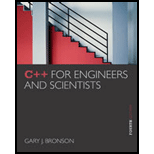
C++ for Engineers and Scientists
4th Edition
ISBN: 9781133187844
Author: Bronson, Gary J.
Publisher: Course Technology Ptr
expand_more
expand_more
format_list_bulleted
Question
Chapter 6.1, Problem 11E
Program Plan Intro
- piValuevariableis used in the program.
- pi () function is include in the program to display the data.
Program Description: The main purpose of the program is to create a function named pi (). This function has no parameter. This function is used to calculate the value of the p. This function display the value of the p.
Expert Solution & Answer
Want to see the full answer?
Check out a sample textbook solution
Students have asked these similar questions
List down the strenghts and weaknesses of your team project for Capsim Simulation? Explan.
Capsim Team PowerPoint Presentations - Slide Title: Key LearningsWhat were the key learnings that you discovered as a team through your Capsim simulation?
Write the SQL code that permits to implement the tables: Student and Transcript. NB: Add the constraints on the attributes – keys and other.
Chapter 6 Solutions
C++ for Engineers and Scientists
Ch. 6.1 - (Practice) For the following function headers,...Ch. 6.1 - Prob. 2ECh. 6.1 - Prob. 3ECh. 6.1 - (Statics) A beam’s second moment of inertia, also...Ch. 6.1 - (Statics) An annulus is a cylindrical rod with a...Ch. 6.1 - Prob. 6ECh. 6.1 - (Physics) Buoyancy is the upward force a liquid...Ch. 6.1 - (Numerical) a. Write a C++ program that accepts an...Ch. 6.1 - (Practice) a. Write a function that produces a...Ch. 6.1 - Prob. 10E
Ch. 6.1 - Prob. 11ECh. 6.1 - Prob. 12ECh. 6.1 - Prob. 13ECh. 6.1 - Prob. 14ECh. 6.1 - Prob. 15ECh. 6.2 - Prob. 1ECh. 6.2 - (Practice) For the following function headers,...Ch. 6.2 - (General math) a. Write a function named...Ch. 6.2 - (General math) a. The volume, V, of a cylinder is...Ch. 6.2 - Prob. 6ECh. 6.2 - Prob. 10ECh. 6.2 - (Numerical) a. The following is an extremely...Ch. 6.2 - Prob. 12ECh. 6.2 - Prob. 13ECh. 6.3 - Prob. 2ECh. 6.3 - Prob. 4ECh. 6.3 - Prob. 5ECh. 6.4 - (Practice) The volume, v, and side surface area,...Ch. 6.4 - (Practice) Write a C++ program that accepts the...Ch. 6.4 - (Simulation) Write a program to simulate the roll...Ch. 6.4 - (Numerical) Write a program that tests the...Ch. 6 - Prob. 1PPCh. 6 - Prob. 2PPCh. 6 - Prob. 6PPCh. 6 - (Numerical) Heron’s formula for the area, A, of a...Ch. 6 - Prob. 10PP
Knowledge Booster
Similar questions
- Draw an ERD that will involve the entity types: Professor, Student, Department and Course. Be sure to add relationship types, key attributes, attributes and multiplicity on the ERD.arrow_forwardDraw an ERD that represents a book in a library system. Be sure to add relationship types, key attributes, attributes and multiplicity on the ERD.arrow_forward2:21 m Ο 21% AlmaNet WE ARE HIRING Experienced Freshers Salesforce Platform Developer APPLY NOW SEND YOUR CV: Email: hr.almanet@gmail.com Contact: +91 6264643660 Visit: www.almanet.in Locations: India, USA, UK, Vietnam (Remote & Hybrid Options Available)arrow_forward
- Provide a detailed explanation of the architecture on the diagramarrow_forwardhello please explain the architecture in the diagram below. thanks youarrow_forwardComplete the JavaScript function addPixels () to calculate the sum of pixelAmount and the given element's cssProperty value, and return the new "px" value. Ex: If helloElem's width is 150px, then calling addPixels (hello Elem, "width", 50) should return 150px + 50px = "200px". SHOW EXPECTED HTML JavaScript 1 function addPixels (element, cssProperty, pixelAmount) { 2 3 /* Your solution goes here *1 4 } 5 6 const helloElem = document.querySelector("# helloMessage"); 7 const newVal = addPixels (helloElem, "width", 50); 8 helloElem.style.setProperty("width", newVal); [arrow_forward
- Solve in MATLABarrow_forwardHello please look at the attached picture. I need an detailed explanation of the architecturearrow_forwardInformation Security Risk and Vulnerability Assessment 1- Which TCP/IP protocol is used to convert the IP address to the Mac address? Explain 2-What popular switch feature allows you to create communication boundaries between systems connected to the switch3- what types of vulnerability directly related to the programmer of the software?4- Who ensures the entity implements appropriate security controls to protect an asset? Please do not use AI and add refrencearrow_forward
arrow_back_ios
SEE MORE QUESTIONS
arrow_forward_ios
Recommended textbooks for you
 C++ for Engineers and ScientistsComputer ScienceISBN:9781133187844Author:Bronson, Gary J.Publisher:Course Technology Ptr
C++ for Engineers and ScientistsComputer ScienceISBN:9781133187844Author:Bronson, Gary J.Publisher:Course Technology Ptr C++ Programming: From Problem Analysis to Program...Computer ScienceISBN:9781337102087Author:D. S. MalikPublisher:Cengage Learning
C++ Programming: From Problem Analysis to Program...Computer ScienceISBN:9781337102087Author:D. S. MalikPublisher:Cengage Learning

C++ for Engineers and Scientists
Computer Science
ISBN:9781133187844
Author:Bronson, Gary J.
Publisher:Course Technology Ptr

C++ Programming: From Problem Analysis to Program...
Computer Science
ISBN:9781337102087
Author:D. S. Malik
Publisher:Cengage Learning